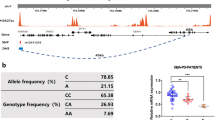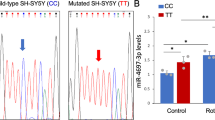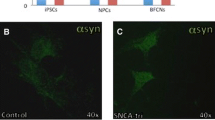Abstract
Parkinson’s disease (PD) is a common neurodegenerative disorder affecting millions of people worldwide, but its cause and pathogenesis are still not fully understood. Earlier studies have shown that SNCA, which encodes α-synuclein, is one of the key genes associated with PD. Single-nucleotide polymorphism (SNP) variants of SNCA are thought to be correlated with disease onset. The underlying mechanisms however are enigmatic. A recent study published in Nature revealed that one of the SNP variants in the SNCA non-coding element elevated α-synuclein expression in human neurons by reducing the binding efficiency of transcription factors, demonstrating a previously uncharted role for SNPs in the pathogenesis of PD.
Similar content being viewed by others
Avoid common mistakes on your manuscript.
Parkinson’s disease (PD) is a common degenerative disorder of the central nervous system, affecting millions of people in the aging global population. Most cases of PD are sporadic, possibly caused by complex interactions between common genetic and environmental risk factors [1], thus making it difficult to elucidate the exact pathogenic mechanisms.
In the last several decades, however, many efforts have been made to decode the pathogenesis of PD. Some researchers have used genome-wide association studies (GWASs), a method to search for genetic variants in large cohorts of patients, to identify risk genes and mutations associated with PD [2, 3]. GWASs typically focus on single-nucleotide polymorphisms (SNPs) [2] and have identified a host of PD susceptibility SNPs that are significantly more frequent in populations with the disease. However, GWASs alone cannot tell us about causal relationships between specific risk variants and the associated diseases. Thus, the exact mechanisms underlying the genetic variants and the risk of their associated diseases remain enigmatic [2].
A recent study has shed a new light on the association between SNCA variants and the pathogenesis of PD. Soldner et al. [4] used clustered regularly-interspaced short palindromic repeats (CRISPR)/Cas9 (CRISPR-associated protein 9), a powerful gene-editing technique, to analyze variants in the SNCA gene which encodes α-synuclein. They found that a common variant in a non-coding distal enhancer element increases the expression of SNCA by affecting the sequence-dependent binding of transcription factors (TFs).
According to published GWAS data, SNCA is one of the strongest risk loci in sporadic PD patients [3]. Interestingly, none of the sporadic PD-associated SNPs alters the protein-coding sequence of α-synuclein [5]. Therefore, it has been hypothesized that these variants may elevate the gene expression levels [6], thus leading to abnormal protein aggregation and Lewy body formation, which are classic pathological features of PD. However, validating this hypothesis remains a challenge, since the variants are difficult to manipulate with standard experimental techniques and the impact of one variant might be undetectable in a short time-frame using routine research approaches.
In an attempt to test the hypothesis, Soldner and colleagues focused on candidate risk-associated SNP variants in enhancers of the SNCA gene, based on the assumption that an enhancer would influence gene expression and specific SNP alterations would change the gene expression levels by influencing the activity of cis-acting elements [7]. By using CRISPR/Cas9, the suspect enhancer region that contains two risk-associated SNPs, rs356168 and rs3756054, was deleted in human embryonic stem cells. Then one of the two enhancer-deleted alleles was inserted with one possible variant of the two risk-associated SNPs, thus generating four heterozygous cells, with the homozygous enhancer-deleted cell as control. Subsequently, the cells were induced to differentiate into either neural precursors or neurons.
Next, the investigators used TaqMan SNP genotyping assays to quantify the relative levels of the distinct SNCA mRNA transcripts in the genetically re-engineered cells. Allele-specific quantitative reverse transcription polymerase chain reaction (qRT–PCR) analysis revealed a significant increase in the SNCA expression levels in neural precursors and neurons carrying the G allele at rs356168 compared with cells carrying the A allele at the same SNP site and the homozygous enhancer-deleted cells. These results suggested that the common SNP at rs356168 could regulate the transcription of SNCA in human neural precursors and neurons.
It has been proposed that different sequence variants lead to differential TF binding, which can alter the enhancer activity, resulting in differential gene expression [8]. The authors identified two brain-specific TFs, NKX6-1 and EMX2, which function as transcription suppressors [9–11]. These two TFs showed preferential binding to the A allele at rs356168 rather than the G allele. Consequently, enhancer activity was less repressed with the G allele at rs356168, which then led to higher SNCA expression.
In summary, the authors found that a common risk-associated sequence variant can modulate the expression of the α-synuclein gene through altering the binding efficiency of the TFs to the enhancer. This is the first time that the influences of genetic variants on PD risk have been elucidated at the molecular level using CRISPR/Cas9 technology based on GWAS data, thus providing strong evidence that non-coding genetic variants may elevate gene expression levels.
The authors elegantly and carefully described a new strategy to analyze the influence of a specific variant on the expression of a disease-causing gene. Using CRISPR/Cas9-mediated genome editing, they were able to precisely delete and insert targeted sequences. This strategy allows researchers to analyze the functions of two or more closely-located SNP variants by modifying them individually. Since GWASs have identified many important risk-associated variants for PD, and their impact on disease onset and progression remains largely unknown, this strategy can be used to study other risk loci associated with sporadic PD as well as other diseases such as Alzheimer’s disease, multiple sclerosis, diabetes, and cancers.
Induced pluripotent stem cells (iPSCs) can be generated from patients carrying disease-associated risk variants and can be differentiated into disease-relevant cell types for further study. This appears to be an effective strategy for investigating the mechanisms underlying disease-specific phenotypes. Nevertheless, individual iPSC lines often display significantly diverse biological properties, making the differentiation process unpredictable [12]. Therefore, such iPSCs are of limited value as in vitro models of genetic diseases. Remarkably, in the study by Soldner et al., the authors edited the genetic variants precisely via CRISPR/Cas9, and as a result, generated heterozygous cells. Using the other allele in the same cell as an optimal control, the effect of inherent system variability was eliminated. Moreover, in combination with TaqMan qRT–PCR analysis, the allele-specific expression levels can be quantified in a single multiplex reaction, thus allowing the small effect of a specific variant to be detectable.
It is worth pointing out that this study also has some limitations. For example, although transcriptional regulation was indicated in the study, other possible regulatory mechanisms of the disease-associated variants have not been ruled out. A previous study showed that the 3′-untranslated region promoted the accumulation and translation of α-synuclein transcripts [13], indicating the complexity of mechanisms regulating α-synuclein expression. It would be interesting to determine the relationship between the enhancer PD-associated SNPs and the 3′-untranslated region of α-synuclein. Another question is whether the in vitro data presented in this study truly reflect the situation in vivo. To address this question, one may consider using recently-developed techniques that enable direct observation in brain slices, and even in animal brains. For example, high-resolution in vivo imaging techniques make it possible to see the dynamics of a single molecule in a living cell. Among these sophisticated techniques, lattice light-sheet microscopy allows non-invasive 3D imaging of fast intracellular dynamic processes in living specimens with low photobleaching and phototoxicity [14]. The expression and localization of GFP-tagged proteins such as α-synuclein can be visualized and tracked. It is anticipated that the application of neuroimaging techniques will help to determine the functional relationships between genetic variants and targeted proteins in vivo. The data generated from these studies will ultimately provide new insights into exactly how increased α-synuclein expression leads to PD.
References
Tatton WG, Chalmers-Redman R, Brown D, Tatton N. Apoptosis in Parkinson’s disease: signals for neuronal degradation. Ann Neurol 2003, 53 Suppl 3: S61–70; discussion S70–62.
Manolio TA. Genomewide association studies and assessment of the risk of disease. N Engl J Med 2010, 363: 166–176.
Nalls MA, Pankratz N, Lill CM, Do CB, Hernandez DG, Saad M, et al. Large-scale meta-analysis of genome-wide association data identifies six new risk loci for Parkinson’s disease. Nat Genet 2014, 46: 989–993.
Soldner F, Stelzer Y, Shivalila CS, Abraham BJ, Latourelle JC, Barrasa MI, et al. Parkinson-associated risk variant in distal enhancer of alpha-synuclein modulates target gene expression. Nature 2016, 533: 95–99.
Abeliovich A, Rhinn H. Parkinson’s disease: guilt by genetic association. Nature 2016, 533: 40–41.
Devine MJ, Gwinn K, Singleton A, Hardy J. Parkinson’s disease and alpha-synuclein expression. Mov Disord 2011, 26: 2160–2168.
Roadmap Epigenomics C, Kundaje A, Meuleman W, Ernst J, Bilenky M, Yen A, et al. Integrative analysis of 111 reference human epigenomes. Nature 2015, 518: 317–330.
Kilpinen H, Waszak SM, Gschwind AR, Raghav SK, Witwicki RM, Orioli A, et al. Coordinated effects of sequence variation on DNA binding, chromatin structure, and transcription. Science 2013, 342: 744–747.
Schaffer AE, Freude KK, Nelson SB, Sander M. Nkx6 transcription factors and Ptf1a function as antagonistic lineage determinants in multipotent pancreatic progenitors. Dev Cell 2010, 18: 1022–1029.
Mariani J, Favaro R, Lancini C, Vaccari G, Ferri AL, Bertolini J, et al. Emx2 is a dose-dependent negative regulator of Sox2 telencephalic enhancers. Nucleic Acids Res 2012, 40: 6461–6476.
Ligon KL, Echelard Y, Assimacopoulos S, Danielian PS, Kaing S, Grove EA, et al. Loss of Emx2 function leads to ectopic expression of Wnt1 in the developing telencephalon and cortical dysplasia. Development 2003, 130: 2275–2287.
Soldner F, Jaenisch R. Medicine. iPSC disease modeling. Science 2012, 338: 1155–1156.
Rhinn H, Qiang L, Yamashita T, Rhee D, Zolin A, Vanti W, et al. Alternative alpha-synuclein transcript usage as a convergent mechanism in Parkinson’s disease pathology. Nat Commun 2012, 3: 1084.
Chen BC, Legant WR, Wang K, Shao L, Milkie DE, Davidson MW, et al. Lattice light-sheet microscopy: imaging molecules to embryos at high spatiotemporal resolution. Science 2014, 346: 1257998.
Author information
Authors and Affiliations
Corresponding author
Rights and permissions
About this article
Cite this article
Lu, S., Zhou, J. Finding the ‘Guilty’ Gene Variant of Sporadic Parkinson’s Disease Via CRISPR/Cas9. Neurosci. Bull. 33, 115–117 (2017). https://doi.org/10.1007/s12264-016-0065-2
Received:
Accepted:
Published:
Issue Date:
DOI: https://doi.org/10.1007/s12264-016-0065-2




